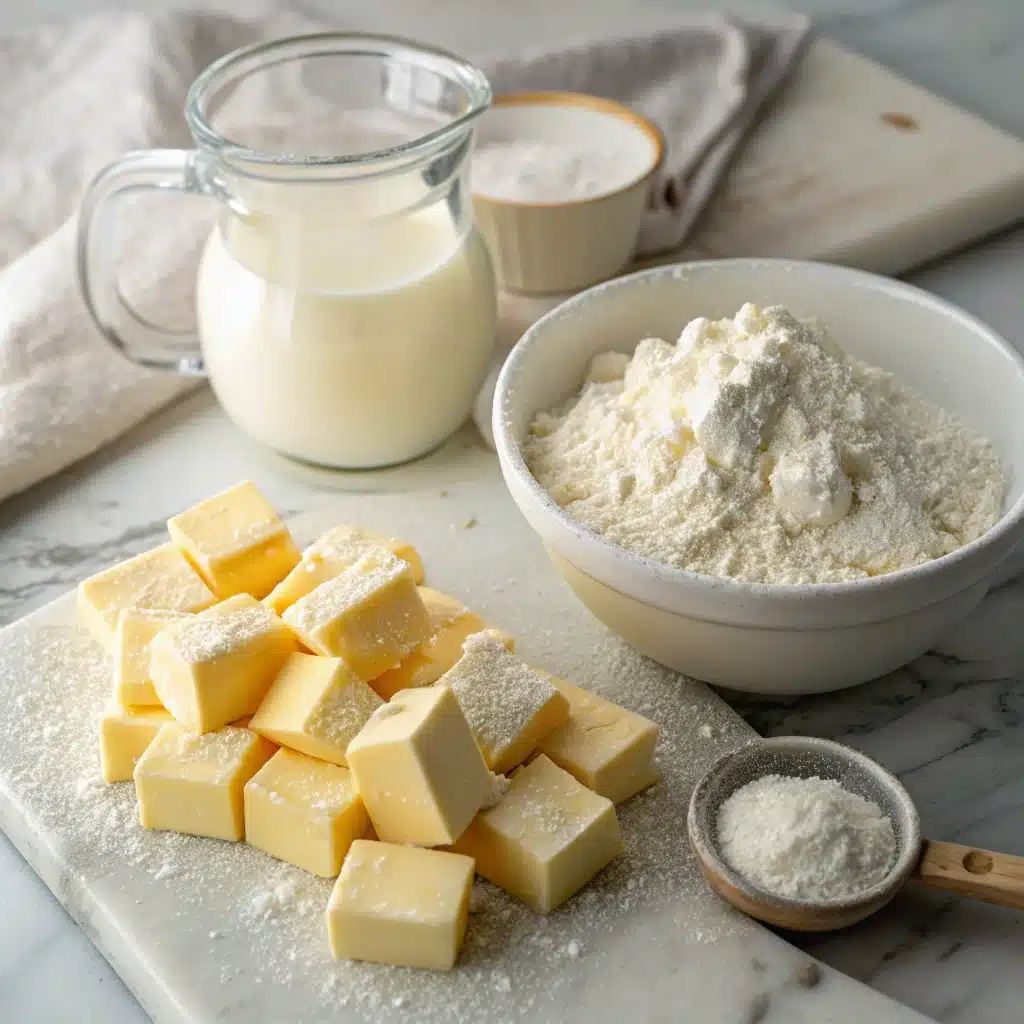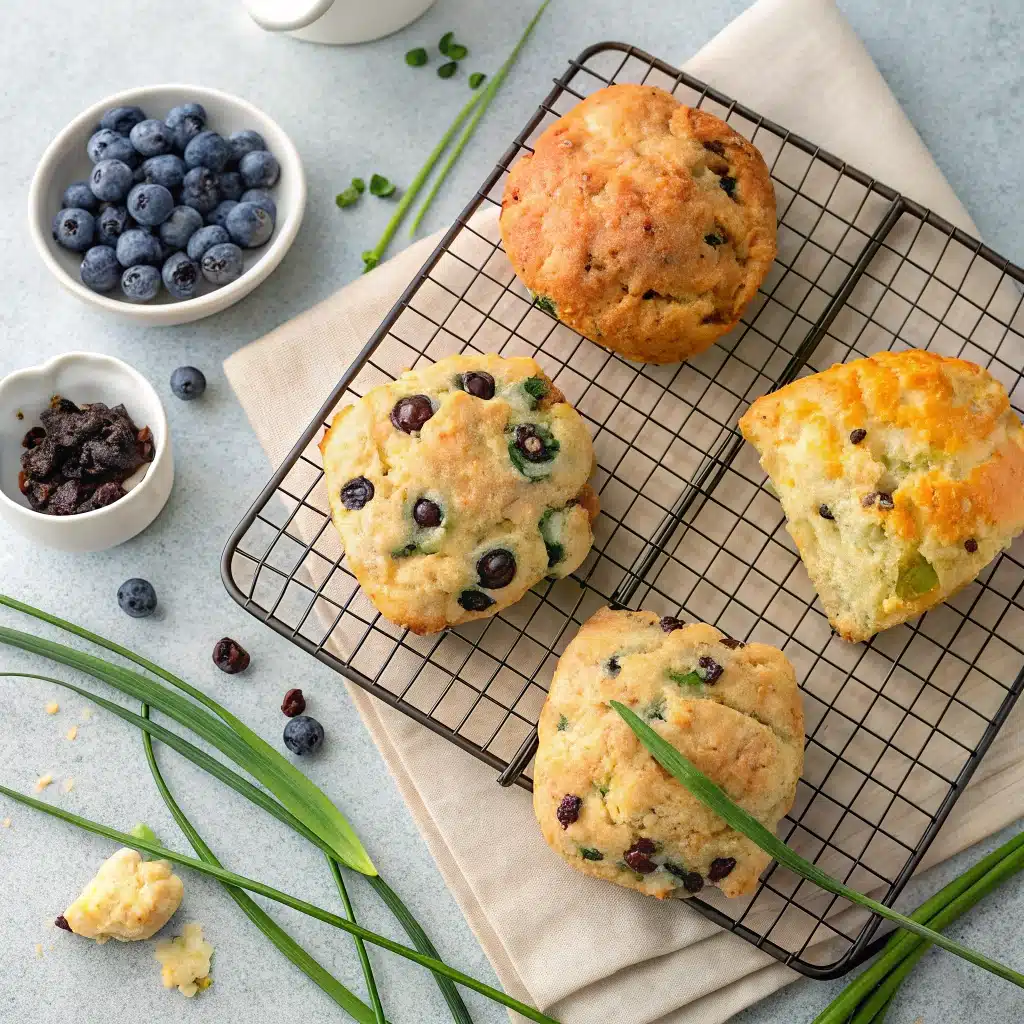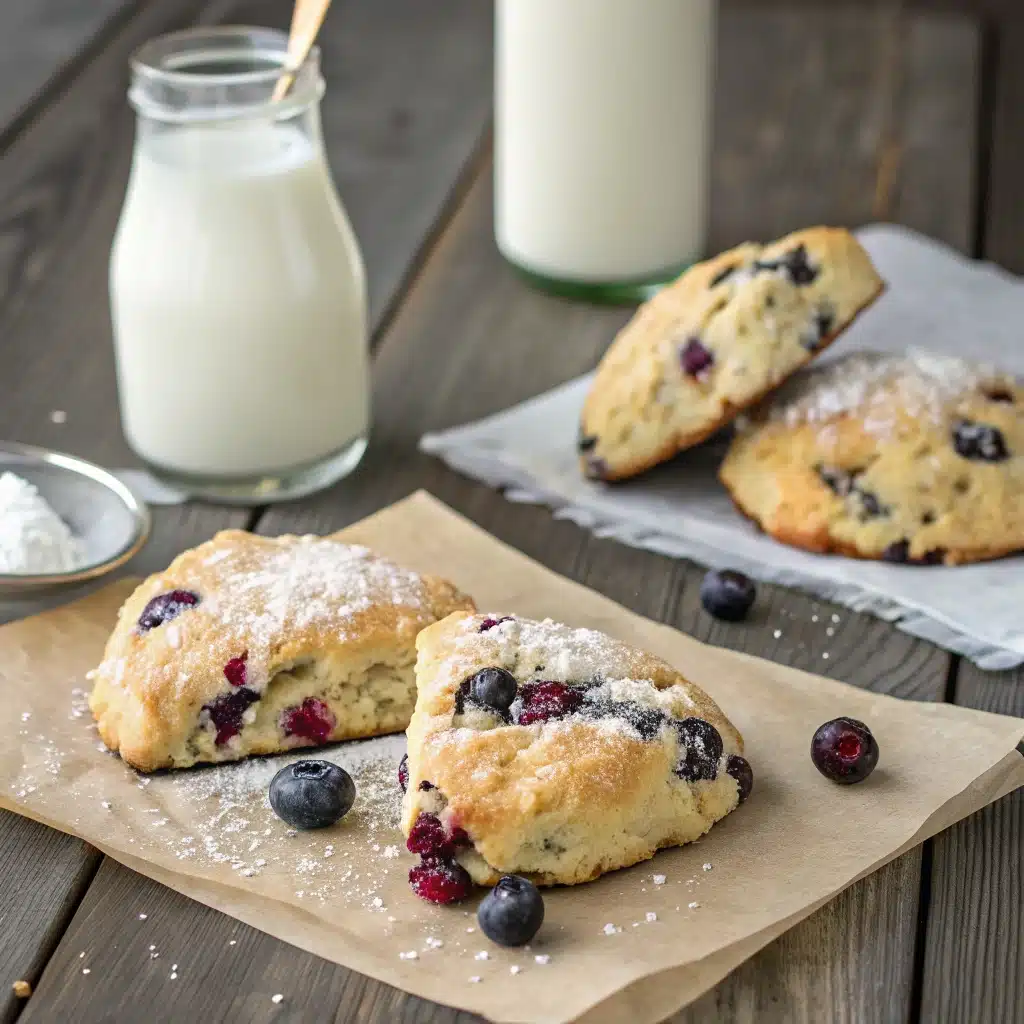Scones have always held a special place in my heart—and on my tea table. I’m Mary, I live in Bath, and I’m known (proudly) as “The Pudding Lady.” My pudding journey began in my mother’s pantry, where golden syrup stuck to the tins and the air smelled of flour and dried fruit. I never trained formally, but I baked endlessly—Victoria sponge, treacle puddings, and, of course, countless batches of scones. Crumbly, warm, and ready to split open for a generous dollop of jam and cream, they became a weekend ritual. Eventually, I started teaching others how to bring them to life in my small pudding club—where the kettle’s always on, and flour ends up absolutely everywhere. Here, we don’t just bake scones—we celebrate them.

Table of Contents
What Are Scones? A Brief History and Definition
A scone is a type of quick bread or pastry that originated in the United Kingdom and has become a staple in both British and American kitchens. The classic British scone is often round, lightly sweetened, and served with clotted cream and jam as part of a traditional cream tea. In contrast, American scones are generally richer, denser, and often triangular in shape, commonly glazed or mixed with sweet add-ins like chocolate chips or fruit.
Print
Scones
- Total Time: 33 minutes
- Yield: 8 scones 1x
- Diet: Vegetarian
Description
Classic buttery scones that are crisp on the outside and tender on the inside—perfect with jam, cream, or your favorite spread.
Ingredients
- 2 cups all-purpose flour
- 1/4 cup sugar
- 1 tablespoon baking powder
- 1/2 teaspoon salt
- 1/2 cup cold unsalted butter, cubed
- 2/3 cup heavy cream
- 1 large egg
- 1 teaspoon vanilla extract
- 1/2 cup add-ins like dried fruit, chocolate chips, or nuts (optional)
- Extra cream and coarse sugar for topping
Instructions
- Preheat oven to 400°F (200°C) and line a baking sheet with parchment paper.
- In a large bowl, whisk together flour, sugar, baking powder, and salt.
- Cut in cold butter with a pastry cutter or fork until mixture resembles coarse crumbs.
- In a small bowl, whisk cream, egg, and vanilla. Add to dry ingredients and mix just until combined.
- Fold in add-ins if using. Do not overmix.
- Turn dough onto a floured surface and gently pat into a 1-inch thick circle. Cut into wedges or use a cutter.
- Place scones on the baking sheet, brush with cream, and sprinkle with coarse sugar.
- Bake for 15–18 minutes or until golden brown.
- Cool slightly and serve warm or at room temperature.
Notes
Scones are best enjoyed fresh. For a flavor twist, add citrus zest or spices to the dough.
- Prep Time: 15 minutes
- Cook Time: 18 minutes
- Category: Breakfast
- Method: Baking
- Cuisine: British
Nutrition
- Serving Size: 1 scone
- Calories: 280
- Sugar: 10g
- Sodium: 210mg
- Fat: 15g
- Saturated Fat: 9g
- Unsaturated Fat: 5g
- Trans Fat: 0g
- Carbohydrates: 32g
- Fiber: 1g
- Protein: 4g
- Cholesterol: 55mg
Historically, the word “scone” is believed to come from the Dutch word “schoonbrood” (fine bread) or the Gaelic “sgonn,” meaning a shapeless mass or large mouthful. The first printed mention dates back to 1513 in Scotland. Once griddled oat cakes, today’s scones are oven-baked with flour, butter, cream or milk, and a touch of baking powder for lift.
Why are scones so loved worldwide? Their charm lies in their crumbly, tender texture and their ability to pair beautifully with both sweet and savory accompaniments. Plus, they’re quick to prepare, making them a go-to for impromptu brunches or tea parties.
British vs. American Scones: Key Differences
While both versions share the same name, British and American scones differ significantly in ingredients, texture, and use.
| Feature | British Scones | American Scones |
|---|---|---|
| Texture | Light, fluffy, less sweet | Denser, crumbly, richer |
| Sweetness | Mildly sweet | Often very sweet |
| Shape | Usually round | Typically triangular |
| Toppings | Served with jam and clotted cream | May contain icing or glaze |
| Add-ins | Rare (occasional currants or raisins) | Frequently includes fruits, nuts, or chocolate chips |
| Purpose | Part of “cream tea” or breakfast | Breakfast, snack, or dessert |
In the U.S., scones tend to resemble dessert-like pastries, ideal with coffee. In the U.K., they’re more of an elegant treat—less sugary, meant to be dressed up after baking with rich toppings.
No matter which version you prefer, scones have adapted to global tastes and dietary needs while holding onto their buttery, comforting essence.
Ingredients
Must-Have Base Ingredients for Scones

Creating the perfect scones begins with a few staple ingredients. These basics are responsible for the texture, rise, and signature flavor that define this beloved pastry.
- All-Purpose Flour
This is the base of most traditional scone recipes. All-purpose flour gives scones the perfect structure—tender, but not too crumbly. - Unsalted Butter (Cold)
Cold butter is the magic behind the flaky texture. When butter melts during baking, it releases steam that puffs up the dough, creating airy layers. Grating or cubing the butter helps it blend evenly into the flour for a consistent texture. - Leavening Agent (Baking Powder or Baking Soda)
Most scone recipes use baking powder to create rise. If your recipe contains buttermilk or acidic ingredients, baking soda might be used alongside or instead. - Salt
It balances the sweetness and enhances the overall flavor. Even sweet scones need a pinch of salt to avoid tasting flat. - Sugar
While British scones are only mildly sweetened, American versions tend to have more sugar, contributing both to flavor and browning. - Milk, Cream, or Buttermilk
These liquids moisten the dough. Buttermilk adds a slight tang and extra tenderness, making it a favorite in many homemade scone recipes. - Eggs (Optional)
Eggs can enrich the dough, giving the scone more structure and color. However, many British-style scones are egg-free.
Pro Tip: Don’t overmix your dough. Too much mixing triggers gluten development, making scones dense and chewy rather than tender and airy.
Optional Add-ins and Flavor Boosters
After nailing the classic scone, get creative with flavors and mix-ins to make it your own. Here are some delicious add-ins and flavor enhancers:
| Category | Add-Ins / Flavorings |
|---|---|
| Sweet | Chocolate chips, blueberries, cranberries, dried cherries, cinnamon |
| Savory | Shredded cheddar, bacon bits, green onions, herbs like rosemary or thyme |
| Liquid Boost | Vanilla extract, almond extract, citrus zest, maple syrup |
| Textural | Chopped nuts, rolled oats, coconut flakes |
For sweet scones, fold in fruits or flavorings after mixing the dry ingredients and cutting in the butter. For savory scones, pair salty elements (like cheese or bacon) with herbs for a balanced bite.
Seasonal Twist Ideas:
- Fall: Apple cinnamon scones
- Summer: Lemon blueberry scones
- Holiday: Peppermint chocolate scones
- Spring: Strawberry basil scones
These variations let you keep scones fresh and exciting for every season or special event.
Don’t miss our recipe for fruit cupcakes to pair perfectly with fruity scones.
How to Make Scones from Scratch
Step-by-Step Scone Dough Preparation
Making scones from scratch is easier than most people think. With a few tools and the right process, you can whip up a batch in under 30 minutes. Follow this simple guide for tender, golden scones every time.
1. Prepare Your Ingredients
Start with cold ingredients, especially the butter. Chill your butter, and if possible, even chill your flour mixture. This ensures flaky layers.
2. Mix Dry Ingredients
In a large bowl, combine flour, sugar, baking powder (and/or baking soda), and salt. Whisk to evenly distribute the leavening.
3. Cut in the Butter
Grate the cold butter or cut it into small cubes. Use a pastry cutter or your fingertips to rub the butter into the flour mixture until it resembles coarse breadcrumbs. Some visible pea-sized pieces of butter are ideal.
4. Add Wet Ingredients
In a separate bowl, whisk together eggs (if using), milk, cream, or buttermilk. Slowly pour the wet mixture into the dry ingredients, stirring gently with a fork or spatula until just combined.
5. Fold in Add-Ins
Gently fold in any extras like berries, cheese, chocolate chips, or herbs. Avoid overmixing—it’s okay if the dough looks a little shaggy.
6. Shape the Dough
Turn the dough onto a lightly floured surface. Pat it into a round disk about 1-inch thick. Use a biscuit cutter for round scones or slice the disk into wedges for triangle scones.
7. Chill the Dough (Optional)
For extra flakiness, chill the shaped scones in the fridge for 15–20 minutes before baking.
8. Bake
Place on a parchment-lined baking sheet, slightly spaced apart. Brush the tops with milk, cream, or an egg wash for a golden finish. Bake at 400°F (200°C) for 15–20 minutes or until golden brown.
Common Mistakes to Avoid While Making Scones
Even simple scone recipes can go wrong without the right care. Avoid these common baking mistakes to ensure fluffy, delicious results:
| Mistake | Fix It With This Tip |
|---|---|
| Overmixing the dough | Mix until just combined. A rough dough is a good thing. |
| Using warm butter | Always use cold butter and liquids to keep dough chilled. |
| Not measuring correctly | Use a kitchen scale or spoon-and-level technique. |
| Skipping chilling step | Chill your dough before baking to prevent spreading. |
| Baking at the wrong temp | Preheat your oven fully—400°F (200°C) is ideal. |
Bonus Tip: Want crispier edges? Space scones apart. Want soft sides? Place them closer together.
Check out our cookie dough cheesecake for another indulgent baked treat you can serve alongside warm scones at brunch.
Different Types of Scones to Try
One of the best things about scones is how easily they adapt to flavors and occasions. Whether you’re craving something sweet for breakfast or a savory bite for brunch, there’s a scone for every mood and moment.
Sweet Scones: Fruit, Chocolate, and Beyond

Sweet scones are what most people imagine when they hear the word “scone.” Soft, slightly crumbly, and bursting with flavor, these are perfect with a cup of tea or coffee.
Popular Sweet Scone Variations
| Flavor Combination | Description |
|---|---|
| Blueberry Lemon | Bright citrus meets juicy berries; best served with lemon glaze. |
| Strawberries & Cream | Fresh strawberries folded into a cream-enriched dough. |
| Chocolate Chip | Semi-sweet chips give a dessert-like twist to classic scones. |
| Apple Cinnamon | Warm spices and diced apples—ideal for fall mornings. |
| Orange Cranberry | Tart cranberries balance the sweetness of orange zest. |
| Vanilla Bean | A subtly flavored base that pairs well with jam and butter. |
Serving Tip:
Brush sweet scones with cream or egg wash and sprinkle with turbinado sugar before baking for a beautiful golden crust.
Looking for inspiration? Try our vanilla cake recipe to mirror the soft, buttery notes of a vanilla scone.
Savory Scones: Cheese, Herb, and Veggie Variations
Savory scones are an excellent alternative to muffins or biscuits for breakfast, brunch, or even light lunch. Rich, buttery, and sometimes spicy, they offer a more complex flavor profile.
Best Savory Scone Ideas
| Combo | Flavor Notes |
|---|---|
| Cheddar & Chive | Sharp cheese and fresh herbs make these ideal with soups. |
| Bacon & Gruyère | Smoky, nutty, and utterly indulgent. |
| Sun-dried Tomato & Feta | Mediterranean flavors packed into a flaky bite. |
| Spinach & Parmesan | A great way to sneak in some greens. |
| Jalapeño & Cheddar | A spicy kick perfect for brunch or game day. |
Savory scones are often brushed with melted butter and sprinkled with cheese or seeds before baking. Serve them warm with whipped butter or even sour cream.
Creative Twist:
Try mixing both worlds—sweet and savory—like a maple bacon scone or a fig and goat cheese scone.
Don’t miss our pistachio raspberry cake if you love nutty, fruity flavor combinations similar to unique scone variations.
Baking Techniques and Tips for Fluffy Scones
Mastering the art of baking scones takes more than just the right ingredients—it’s all about the technique. Master both dough technique and oven tricks to achieve perfectly tall, fluffy scones every time.
Oven Temperature and Timing for Best Results
One of the most important factors in baking great scones is oven heat. A hot oven (400°F / 200°C) encourages an immediate rise, which is key to achieving that flaky, tender texture.
Best Practices for Scone Baking:
- Make sure to preheat your oven for a full 15 minutes to ensure even baking. Inconsistent heat leads to uneven baking.
- Bake on the center rack for balanced heat and to prevent burnt bottoms.
- Bake on parchment paper or a lightly greased baking tray.
- If using egg wash, apply it gently with a brush to just the tops (not the sides), or you’ll prevent the scones from rising evenly.
Bake Time Tip:
Standard-sized scones typically bake for 15–20 minutes. Mini scones need only 10–12 minutes.
If you’re a fan of golden, crusty exteriors, let them go slightly longer—but watch closely to prevent drying.
Try pairing your perfectly baked scones with our matcha tiramisu for a blend of earthy and buttery flavors.
Dough Handling and Shaping Techniques
The way you mix, knead, and shape your dough can make or break your scone game. Remember, scone dough is delicate and should be treated with care.
Top Tips for Handling Dough:
- Minimal mixing is crucial. Handling the dough too much activates gluten, leaving you with chewy, dense scones instead of light and tender ones.
- When turning the dough onto the counter, gently pat (don’t roll) it out into a disk about 1 inch thick.
- Cut straight down with a sharp biscuit cutter—twisting compresses the edges and stops the scones from rising fully.
- To make wedges, slice the dough cleanly with a sharp knife or bench scraper.
- Keep ingredients cold throughout the process—this is what gives you flaky, layered scones.
Bonus Trick:
Stack and gently press layers of dough to create visible, flakier layers—similar to laminated dough techniques used in croissants.
Looking for something richer? Check out our opera cake—it’s another bake that requires precision and technique, just like scones.
Serving and Eating Scones the Right Way
These buttery pastries are more than just a baked good—they’re a beloved part of tea traditions and weekend brunches alike. Whether you’re going classic with jam and cream or modern with maple glaze, how you serve them matters.
Traditional Ways to Serve Them
In British culture, these treats are a key part of a cream tea, typically enjoyed in the afternoon. It includes:
- Freshly baked rounds (plain or raisin)
- Strawberry or raspberry preserves
- Clotted cream
- Hot tea like Earl Grey or English Breakfast
There’s a long-standing debate: jam first or cream first? In Devon, cream goes first. In Cornwall, it’s jam. Both taste amazing.
Serving Tip:
Split them in half with your hands rather than slicing. Then layer with your chosen toppings.
If you’re hosting a tea party, don’t miss our full guide to strawberry simple syrup to sweeten your drinks or drizzle on top.
Best Creams and Jams to Pair
Toppings elevate a simple batch from good to unforgettable. Clotted cream may be classic, but there’s no shortage of tasty substitutes to try.
Spread Options
| Type | Description & Pairings |
|---|---|
| Clotted Cream | Thick and rich, perfect with fruity fillings |
| Whipped Cream | Airy and light, ideal for sweet flavors |
| Mascarpone | A smooth cheese that pairs well with berry spreads |
| Lemon Curd | Bright and tangy; adds zip to vanilla or citrus-infused variations |
| Butter & Honey | A timeless combo, especially for savory versions |
Jam Favorites
| Flavor | Best With |
|---|---|
| Strawberry | A traditional favorite |
| Raspberry | Tart enough to balance sweet elements |
| Apricot | Delicious with anything nutty or spiced |
| Blackberry | Ideal with warm spices like cinnamon |
| Fig Jam | An elegant choice for cheese-infused varieties |
A light dusting of powdered sugar or a drizzle of glaze adds a pretty touch and complements the toppings.
Storing and Reheating Scones
So, you’ve baked a fresh batch—now what? Whether you made extras for the week or have leftovers from brunch, proper storage and reheating techniques make all the difference in preserving taste and texture.
How to Keep Them Fresh
Freshly baked goods like these are best enjoyed the day they’re made, but with the right approach, they can last several days.
Short-Term Storage (1–2 Days)
- Let scones cool fully before storing to keep them from turning soggy.
- Place in an airtight container lined with paper towels.
- Store at room temperature, not in the fridge (which can dry them out).
Medium-Term Storage (Up to 1 Week)
- Wrap each piece individually in plastic wrap.
- Refrigerate in an airtight container or zip-top bag to keep them fresh.
- Reheat gently before serving to revive their softness.
Long-Term Storage (Up to 3 Months)
- Wrap tightly in foil or plastic wrap.
- Transfer to a freezer-safe bag, pressing out excess air to prevent freezer burn.
- Label with the date and freeze.
To thaw, leave them at room temperature for a few hours or use a microwave defrost setting.
Reheating Tips for Maintaining Texture
Reheating the right way brings back that just-baked feel—without turning them into bricks.
Oven Method (Best for Texture)
- Preheat your oven to 325°F (160°C).
- Wrap each item in foil to retain moisture.
- Heat for 8–10 minutes, then uncover for 2 minutes to crisp the top.
Microwave Method (Quick Fix)
- Wrap one scone in a damp paper towel.
- Heat for 15–20 seconds on medium power.
- Don’t overheat, or it will become rubbery.
Air Fryer (For a Crisp Finish)
- Preheat air fryer to 300°F.
- Heat for 3–5 minutes.
- Check halfway through to avoid over-browning.
Pair reheated scones with soft butter, honey, or a spoonful of jam to bring them back to life. For a different sweet treat experience, you might enjoy our cupcakes lactose free, which also store and reheat beautifully.
Gluten-Free, Vegan, and Healthier Scone Alternatives

Whether you’re dealing with dietary restrictions or just aiming for cleaner ingredients, there are plenty of ways to enjoy scones without traditional flour, butter, or dairy. These adaptations don’t sacrifice texture or flavor—they just put a healthier spin on an old favorite.
Healthy Scone Ingredient Swaps
Simple substitutions can lighten up your recipe or make it suitable for specialized diets. Here’s how to adjust the basics:
| Traditional Ingredient | Healthier Alternative | Why It Works |
|---|---|---|
| All-purpose flour | Almond flour, oat flour, or GF blend | Lower carbs, gluten-free options |
| Butter | Coconut oil or vegan margarine | Dairy-free, plant-based |
| Heavy cream | Coconut cream, almond milk + vinegar | Vegan and lower in saturated fats |
| Sugar | Maple syrup, honey, or coconut sugar | Less processed and lower glycemic index |
| Eggs | Flaxseed meal + water (1 tbsp + 3 tbsp) | Vegan and cholesterol-free |
Pro Tip: Gluten-free doughs tend to be softer and stickier. It helps to chill them longer and use parchment paper when shaping.
Try these swaps in our suggested base recipes, and don’t forget to experiment with flavors like lemon zest, berries, or spices to keep things exciting.
For more allergen-friendly inspiration, check out our vegan and gluten-free cupcakes—another great bake for those with dietary needs.
Gluten-Free & Dairy-Free Scone Recipes
Below are two crowd-pleasing recipe variations for different dietary goals:
1. Vegan Blueberry Scones
Ingredients:
- 2 cups gluten-free flour blend
- 1/4 cup coconut sugar
- 1 tbsp baking powder
- 1/2 tsp salt
- 1/3 cup coconut oil (solid)
- 3/4 cup almond milk (with 1 tsp apple cider vinegar)
- 1 tsp vanilla extract
- 1 cup fresh blueberries
Instructions:
- Preheat oven to 400°F. Line tray with parchment.
- Mix dry ingredients. Cut in coconut oil.
- Add wet ingredients and berries. Gently mix.
- Form into a disk, cut into wedges. Bake 18–20 mins.
2. Healthy Savory Herb Scones (Low Carb)
Ingredients:
- 1.5 cups almond flour
- 1/2 cup oat flour
- 1 tbsp baking powder
- 1/2 tsp garlic powder
- 1/4 cup nutritional yeast
- 1 tbsp chopped rosemary
- 2 tbsp olive oil
- 1/2 cup almond milk
Instructions:
- Combine dry ingredients, add oil and milk.
- Shape dough into rounds.
- Bake at 375°F for 15–18 minutes.
Storage Tip:
They freeze like a dream and crisp up perfectly in a toaster oven.
Conclusion
Whether you’re making a traditional cream tea, grabbing a quick breakfast bite, or serving guests at brunch, scones bring warmth, charm, and flexibility to any table. From buttery classics to modern gluten-free or vegan versions, these baked delights prove that great flavor never goes out of style.
With this complete guide, you now know how to make them from scratch, choose the right toppings, serve them with confidence, and even adapt recipes for special diets. So, preheat your oven, grab that pastry cutter, and bake something beautiful today.
For more sweet inspiration, don’t miss our roundup of strawberry desserts and cakes to pair with your next afternoon tea!
Fore more recipes follow me in Facebook, medium and Pinterest
FAQs
Comment se mangent les scones ?
Traditionnellement, on les coupe en deux avec les mains (jamais avec un couteau), puis on les garnit de confiture et de crème épaisse (clotted cream). Ils s’accompagnent parfaitement d’un thé noir ou d’un café. Certains préfèrent les beurrer ou les napper de miel. Aux États-Unis, ils sont souvent dégustés au petit-déjeuner ou comme collation.
Translation: They’re usually split by hand and topped with cream and jam—often enjoyed alongside tea or coffee.
Quelle crème avec les scones ?
La crème traditionnelle est la clotted cream, une crème très épaisse, presque beurrée, très populaire en Angleterre. Si elle est difficile à trouver, on peut la remplacer par :
Crème fraîche épaisse
Mascarpone
Chantilly non sucrée
Beurre doux




